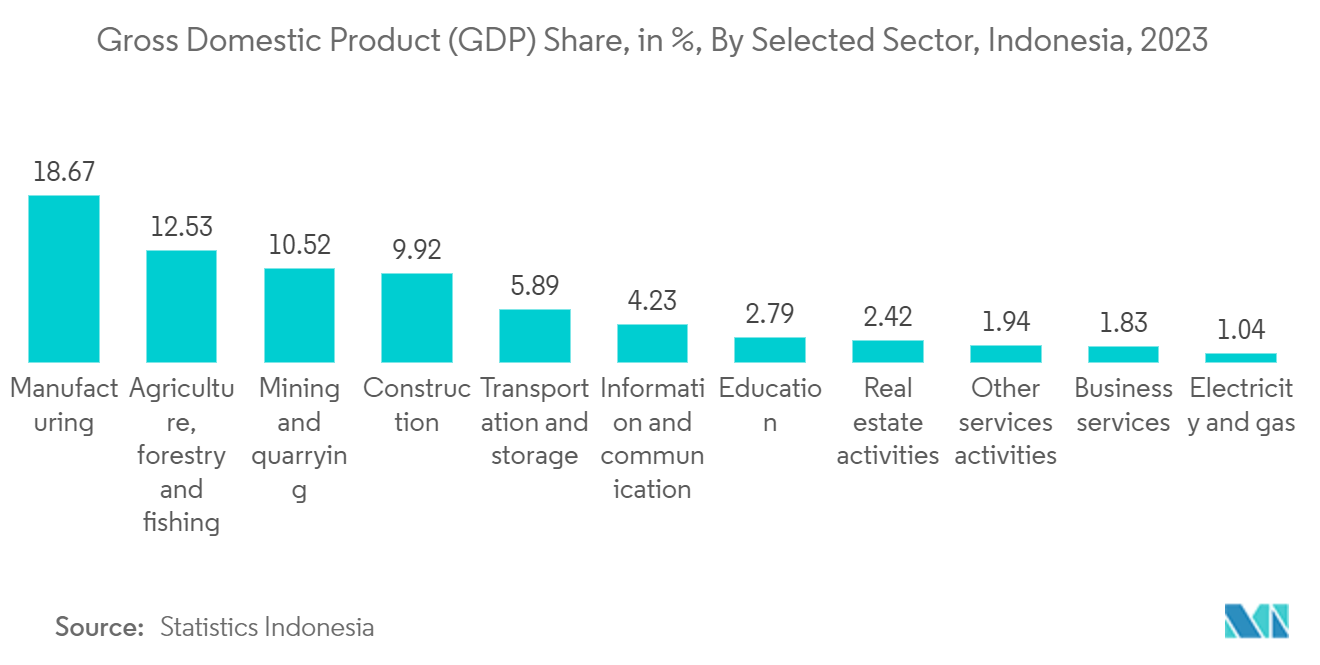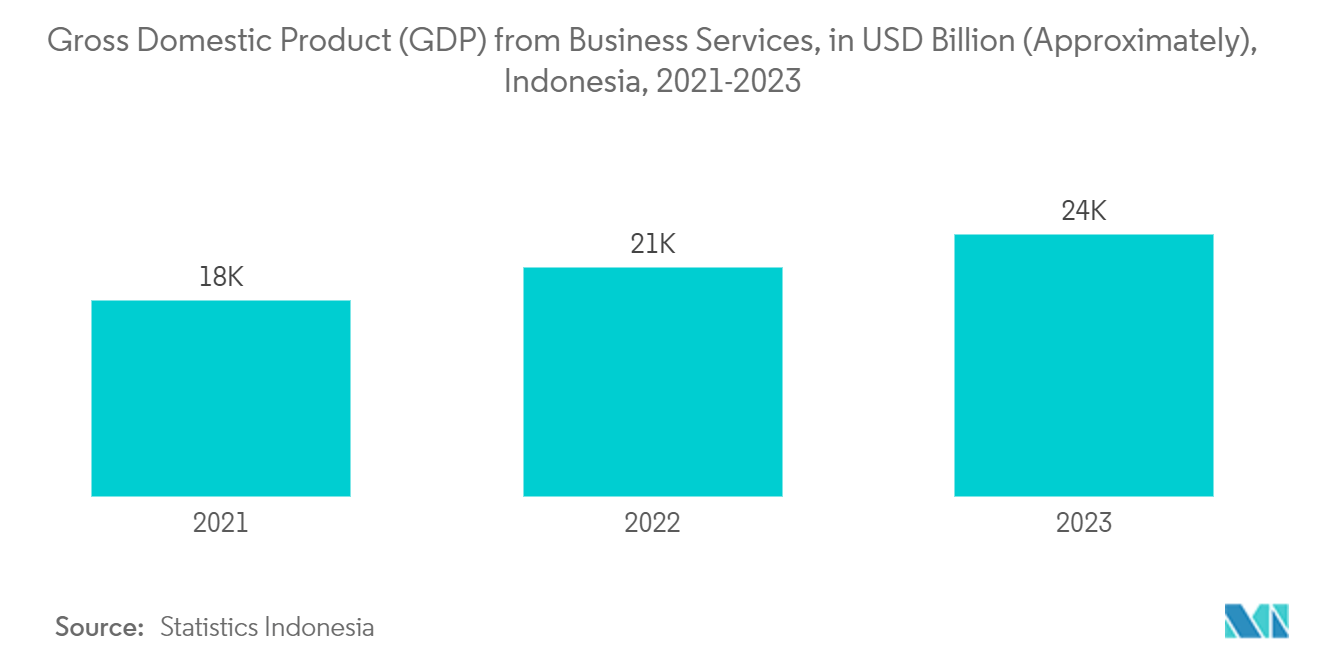Market Trends of Indonesia Robotics Industry
Industrial Robots Expected to Witness a Significant Growth Rate
- Industrial robots are emerging as critical drivers of substantial growth in the rapidly evolving Indonesian robotics market. The industrial landscape in Indonesia is witnessing a surge in the adoption of robotic automation across various sectors, positioning end users as significant contributors to this transformative trend. The manufacturing industry, which produces heavy machinery, automobiles, and electronics, has been driving this technological shift and deploying industrial robots to improve operating efficiency.
- In the automotive sector, industrial robots are becoming integral to production processes, ranging from assembly lines to intricate welding tasks. This heightened integration streamlines manufacturing workflows and responds to the increasing demand for vehicles with precision, efficiency, and adherence to high-quality standards. As automotive manufacturers in Indonesia leverage the advantages of robotic automation, the end users in this sector are poised to play a pivotal role in driving the market's growth.
- Heavy machinery production represents another crucial sector where end-user influence is significant. Industrial robots are increasingly employed for welding, material handling, and intricate assembly tasks. Adopting robotic solutions in heavy machinery manufacturing accelerates production cycles and ensures the precision required in complex processes. As manufacturers in this sector recognize the transformative potential of industrial robots, end users are actively contributing to the burgeoning growth of the robotics market.
- According to Statistics Indonesia, Indonesia's manufacturing sector spearheaded the nation's economy, constituting about 18.67% of the GDP in 2023. The wholesale and retail trade sector followed closely, with agriculture securing the third spot. A growing manufacturing sector often demands higher efficiency, precision, and productivity, which are precisely the characteristics that industrial robots bring to production processes. As manufacturing industries, such as automotive, electronics, and heavy machinery, expand and enhance their operations, adopting industrial robots becomes integral to sustaining and further accelerating this growth.
- Further, the significant increase in end users' adoption of industrial robots aligns with Indonesia's broader goals of technical advancement and economic competitiveness. The government's initiatives to promote innovation and technological adoption further drive this growth. Industry 4.0, emphasizing digital transformation and smart manufacturing, is driving end users to invest in industrial robots for sustainable and efficient production practices.

Sumatra Region is Expected to Hold a Significant Share of the Market
- The Sumatra region, encompassing provinces on Sumatra Island, the Riau Islands, and the Bangka Belitung Islands, is a prime focus for companies engaged in extracting, processing, and transporting commodities. Sumatra is a significant hub for agricultural products, notably palm oil, rice, and rubber, boasting oil, gas, tin, bauxite, and coal. Its strategic positioning adjacent to the Malacca Strait, a vital shipping route between Indonesia and the Malay Peninsula, has heightened its appeal to exporters and the infrastructural entities that support them.
- In a move underscoring this, in June 2023, DP World unveiled plans to amplify the Belawan New Container Terminal's capacity to 1.4 million 20-foot equivalent units as part of a substantial USD 7.5 billion collaboration with Indonesia's sovereign wealth fund, INA, aimed at fortifying the nation's shipping and port industries.
- Manufacturing in developing and underdeveloped nations is witnessing a significant shift toward automation. While this evolution is reshaping the industry, there is also a notable trend of workers increasingly transitioning to the service sector. While contributing to job growth, this shift also exerts downward pressure on wages, leading to a scenario where pay stagnation is more prevalent than widespread unemployment, at least in the near to medium term. While the rise of digital technologies poses a perceived existential threat to manufacturing in developing nations, these concerns are often rooted in technical capabilities. Yet, the automation of jobs hinges not just on technical feasibility but also on economic and institutional factors, which can hold more weight in underdeveloped economies.
- The e-commerce industry's order fulfillment contributes significantly to the expanding use of logistics robots. Due to increased online consumers, merchants are compelled to adopt the automation process to execute repetitive activities utilizing robotic solutions to keep up with delivery schedules. Furthermore, effective digital automation network integration provides a real-time picture of activities. As a result, factories, transportation companies, and other organizations may examine the state of their operations in real-time. This function is crucial for the e-commerce industry because it focuses on meeting consumers' expectations on time. This contributes to the market's growth as well.
- Sanitation has been a growing challenge, particularly in densely populated places. Restaurants, hospitals, hotels, airports, and schools are just a few examples. As a result, the market is witnessing an increasing number of businesses and organizations opt for automated systems to disinfect workplaces and public places.
- There are multiple methods to sterilize space in hospitals, including UV disinfection. UV radiation ranging from 200 to 300 nm can neutralize microorganisms such as bacteria and viruses, disinfecting air and solid surfaces. Within 10 minutes, ultraviolet disinfection robots can kill 99.9% of all bacteria in a hospital room. While the room must be vacant during disinfection, the UV rays have no detrimental impact. These robots do not replace cleaning workers, who must remove 'hard' stains like blood and other substances.
- Moreover, according to Statistics Indonesia, preliminary figures in 2023 showed that the gross domestic product (GDP) from business services in Indonesia amounted to approximately USD 24,000 billion. The service sector's substantial contribution presents a considerable market for service robots to enhance efficiency and innovation in various service-oriented industries. This would propel market players to develop new service robots to capture market share.


